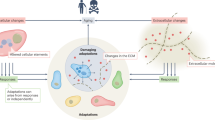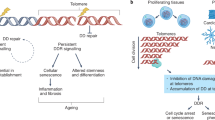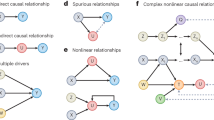Abstract
Replicative aging is the process by which most normal human cells “count” the number of times they have divided, eventually undergoing a growth arrest termed cellular senescence. This process is dependent on the shortening of telomeres, repeated sequences at the ends of the chromosomes. The loss of telomeric sequences with each cell division eventually induces a growth arrest that has a similar phenotype to that of cells stressed by inadequate culture or other conditions. Experiments over the past several years have identified species in which replicative aging does not occur and many examples in which a failure to proliferate has been misinterpreted as replicative senescence. Insights from these studies now permit a reevaluation of much of the seemingly contradictory data concerning replicative aging. There are good theoretical reasons for believing a limited proliferative capacity contributes to declining tissue homeostasis with increasing age. Although the presence of telomere shortening provides strong circumstantial evidence that replicative aging is occurring in vivo, thus far there is only very limited direct evidence for actual physiological effects of replicative aging.
This is a preview of subscription content, access via your institution
Access options
Subscribe to this journal
Receive 12 print issues and online access
$209.00 per year
only $17.42 per issue
Buy this article
- Purchase on Springer Link
- Instant access to full article PDF
Prices may be subject to local taxes which are calculated during checkout


Similar content being viewed by others
References
Kirkwood, T.B. The nature and causes of ageing. Ciba Found. Symp. 134, 193–207 (1988).
Finch, C.E. Longevity, Senescence, and the Genome (University of Chicago Press, Chicago; 1990), p. 922.
Bucala, R. & Cerami, A. Advanced glycosylation: chemistry, biology, and implications for diabetes and aging. Adv. Pharmacol. 23, 1–34 (1992).
Vogelstein, B. & Kinzler, K.W. The multistep nature of cancer. Trends Genet. 9, 138–141 (1993).
Kim, N.W. et al. Specific association of human telomerase activity with immortal cells and cancer. Science 266, 2011–2015 (1994).
Shay, J.W. & Bacchetti, S. A survey of telomerase activity in human cancer. Eur. J. Cancer 5, 787–791 (1997).
Oikawa, S. & Kawanishi, S. Site-specific DNA damage at GGG sequence by oxidative stress may accelerate telomere shortening. FEBS Lett. 453, 365–368 (1999).
Dernberg, A.F., Sedat, J.W., Cande, W.Z., & Bass, H.W. Cytology of telomeres. in Telomeres (eds Blackburn, E.H. & Greider, C.W.) 295–338 (Cold Spring Harbor Monograph Series, Cold Spring Harbor, NY; 1995).
Oh, H. et al. Telomerase reverse transcriptase promotes cardiac muscle cell proliferation, hypertrophy, and survival. Proc. Natl. Acad. Sci. USA 98, 10308–10313 (2001).
Mattson, M.P. & Klapper, W. Emerging roles for telomerase in neuronal development and apoptosis. J. Neurosci. Res. 63, 1–9 (2001).
Klapper, W., Heidorn, K., Kuhne, K., Parwaresch, R. & Krupp, G. Telomerase activity in 'immortal' fish. FEBS Lett. 434, 409–412 (1998).
Sherr, C.J. & DePinho, R.A. Cellular senescence: mitotic clock or culture shock? Cell 102, 407–410 (2000).
Wright, W.E. & Shay, J.W. Telomere dynamics in cancer progression and prevention: fundamental differences in human and mouse telomere biology. Nat. Med. 6, 849–851 (2000).
Wright, W.E. & Shay, J.W. Cellular senescence as a tumor-protection mechanism: the essential role of counting. Curr. Opin. Genet. Dev. 11, 98–103 (2001).
Vulliamy, T. et al. The RNA component of telomerase is mutated in autosomal dominant dyskeratosis congenita. Nature 413, 432–435 (2001).
Mitchell, J.R., Wood, E., & Collins, K. A telomerase component is defective in the human disease dyskeratosis congenita. Nature 402, 551–555 (1999).
Blasco, M.A. et al. Telomere shortening and tumor formation by mouse cells lacking telomerase RNA. Cell 91, 25–34 (1997).
Mendrysa, S.M. & Perry, M.E. The p53 tumor suppressor protein does not regulate expression of its own inhibitor, MDM2, except under conditions of stress. Mol. Cell. Biol. 20, 2023–2230 (2000).
Nussenzweig, A. et al. Requirement for Ku80 in growth and immunoglobulin V(D)J recombination. Nature 382, 551–555 (1996).
Barlow, C. et al. Atm-deficient mice: a paradigm of ataxia telangiectasia. Cell 86, 159–171 (1996).
Connor, F. et al. Tumorigenesis and a DNA repair defect in mice with a truncating Brca2 mutation. Nat. Genet. 17, 423–430 (1997).
Harada, Y.N. et al. Postnatal growth failure, short life span, and early onset of cellular senescence and subsequent immortalization in mice lacking the xeroderma pigmentosum group G gene. Mol. Cell Biol. 19, 2366–2372 (1999).
Kamijo, T. et al. Tumor suppression at the mouse INK4a locus mediated by the alternative reading frame product p19ARF. Cell 91, 649–659 (1997).
Loo, D.T., Fuquay, J.I., Rawson, C.L. & Barnes, D.W. Extended culture of mouse embryo cells without senescence: inhibition by serum. Science 236, 200–202 (1987).
Tang, D.G., Tokumoto, Y.M., Apperly, J.A., Lloyd, A.C. & Raff, M.C. Lack of replicative senescence in cultured rat oligodendrocyte precursor cells. Science 291, 868–871 (2001).
Mathon, N.F., Malcolm, D.S., Harrisingh, M.C., Cheng, L. & Lloyd, A.C. Lack of replicative senescence in normal rodent glia. Science 291, 872–875 (2001).
Harley, C.B. Telomere loss: mitotic clock or genetic time bomb? Mutat. Res. 256, 271–282 (1991).
Robles, S.J. & Adami, G.R. Agents that cause DNA double strand breaks lead to p16INK4a enrichment and the premature senescence of normal fibroblasts. Oncogene 16, 1113–1123 (1998).
Severino, J., Allen, R.G., Balin, S., Balin, A. & Cristofalo, V.J. Is β-galactosidase staining a marker of senescence in vitro and in vivo? Exp. Cell Res. 257, 162–171 (2000).
Chen, Q. & Ames, B.N. Senescence-like growth arrest induced by hydrogen peroxide in human diploid fibroblast F65 cells. Proc. Natl. Acad. Sci. USA 91, 4130–4134 (1994).
Serrano, M., Lin, A.W., McCurrach, M.E., Beach, D. & Lowe, S.W. Oncogenic ras provokes premature cell senescence associated with accumulation of p53 and p16INK4a. Cell 88, 593–602 (1997).
Zhu, J., Woods, D., McMahon, M. & Bishop, J.M. Senescence of human fibroblasts induced by oncogenic Raf. Genes Dev. 12, 2997–3007 (1998).
Dimri, G.P., Itahana, K., Acosta, M. & Campisi, J. Regulation of a senescence checkpoint response by the E2F1 transcription factor and p14(ARF) tumor suppressor. Mol. Cell. Biol. 20, 273–285 (2000).
Drayton, S. & Peters, G. Immortalisation and transformation revisited. Curr. Opin. Genet. Dev. 12, 98–104 (2002).
Shay, J.W. & Wright, W.E. Aging. When do telomeres matter? Science 291, 839–840 (2001).
Vaziri, H. & Benchimol, S. Reconstitution of telomerase activity in normal human cells leads to elongation of telomeres and extended replicative life span. Curr. Biol. 8, 279–282 (1998).
Bodnar, A.G. et al. Extension of life-span by introduction of telomerase into normal human cells. Science 279, 349–352 (1998).
Steinert, S., White, D.M., Zou, Y., Shay, J.W. & Wright, W.E. Telomere biology and cellular aging in nonhuman primate cells. Exp. Cell. Res. 272, 146–152 (2002).
Thomas, M., Yang, L. & Hornsby, P.J. Formation of functional tissue from transplanted adrenocortical cells expressing telomerase reverse transcriptase. Nat. Biotechnol. 18, 39–42 (2000).
Rubin, H. Cell aging in vivo and in vitro. Mech. Ageing Dev. 98, 1–35 (1997).
Rubin, H. Telomerase and cellular lifespan: ending the debate? Nat. Biotechnol. 16, 396–397 (1998).
Rubin, H. The relation between lifespan of a species and the number of doublings of its cells in culture is an unresolved issue. Mech. Ageing Dev. 100, 209–210 (1998).
Rubin, H. Multistage carcinogenesis in cell culture. Dev. Biol. 106, 61–66 (2001).
Romanov, S.R. et al. Normal human mammary epithelial cells spontaneously escape senescence and acquire genomic changes. Nature 409, 633–637 (2001).
Kiyono, T. et al. Both Rb/p16INK4a inactivation and telomerase activity are required to immortalize human epithelial cells. Nature 396, 84–88 (1998).
Jarrard, D.F. et al. p16/pRb pathway alterations are required for bypassing senescence in human prostate epithelial cells. Cancer Res. 59, 2957–2964 (1999).
Dickson, M.A. et al. Human keratinocytes that express hTERT and also bypass a p16(INK4a)- enforced mechanism that limits life span become immortal yet retain normal growth and differentiation characteristics. Mol. Cell Biol. 20, 1436–1447 (2000).
Farwell, D.G. et al. Genetic and epigenetic changes in human epithelial cells immortalized by telomerase. Am. J. Pathol. 156, 1537–1547 (2000).
Ramirez, R.D. et al. Putative telomere-independent mechanisms of replicative aging reflect inadequate growth conditions. Genes Dev. 15, 398–403 (2001).
Saito, H., Hammond, A.T. & Moses, R.E. The effect of low oxygen tension on the in vitro-replicative life span of human diploid fibroblast cells and their transformed derivatives. Exp. Cell. Res. 217, 272–279 (1995).
Packer, L. & Fuehr, K. Low oxygen concentration extends the lifespan of cultured human diploid cells. Nature 267, 423–425 (1977).
Atamna, H., Paler-Martinez, A. & Ames, B.N. N-t-butyl hydroxylamine, a hydrolysis product of α-phenyl-N-t-butyl nitrone, is more potent in delaying senescence in human lung fibroblasts. J. Biol. Chem. 275, 6741–6748 (2000).
Cristofalo, V.J. Thymidine labelling index as a criterion of aging in vitro. Gerontology 22, 9–27 (1976).
Taylor, W.G., Richter, A., Evans, V.J. & Sanford, K.K. Influence of oxygen and pH on plating efficiency and colony development of WI-38 and Vero cells. Exp. Cell. Res. 86, 152–156 (1974).
McKeehan, W.L. & Ham, R.G. Methods for reducing the serum requirement for growth in vitro of nontransformed diploid fibroblasts. Dev. Biol. Stand. 37, 97–98 (1976).
Wolf, N.S. & Pendergrass, W.R. The relationships of animal age and caloric intake to cellular replication in vivo and in vitro: a review. J. Gerontol. A Biol. Sci. Med. Sci. 54, B502–B517 (1999).
Schultz, E. & Lipton, B.H. Skeletal muscle satellite cells: changes in proliferation potential as a function of age. Mech. Ageing Dev. 20, 377–383 (1982).
Smith, J.R. & Hayflick, L. Variation in the life-span of clones derived from human diploid cell strains. J. Cell. Biol. 62, 48–53 (1974).
Smith, J.R. & Whitney, R.G. Intraclonal variation in proliferative potential of human diploid fibroblasts: stochastic mechanism for cellular aging. Science 207, 82–84 (1980).
Martin, G.M., Sprague, C.A., Norwood, T.H. & Pendergrass, W.R. Clonal selection, attenuation and differentiation in an in vitro model of hyperplasia. Am. J. Pathol. 74, 137–154 (1974).
Smith, J.R., Pereira-Smith, O.M. & Schneider, E.L. Colony size distributions as a measure of in vivo and in vitro aging. Proc. Natl. Acad. Sci. USA 75, 1353–1356 (1978).
Harley, C.B., Fletcher, A.B. & Greider, C.W. Telomeres shorten during aging. Nature 345, 458–460 (1990).
Vaziri, H. et al. Loss of telomeric DNA during aging of normal and trisomy 21 human lymphocytes. Am. J. Hum. Genet. 52, 661–667 (1993).
Shay, J.W., Wright, W.E., Brasiskyte, D. & Van der Haegen, B.A. E6 of human papillomavirus type 16 can overcome the M1 stage of immortalization in human mammary epithelial cells but not in human fibroblasts. Oncogene 8, 1407–1413 (1993).
Huffman, K.E., Levene, S.D., Tesmer, V.M., Shay, J.W. & Wright, W.E. Telomere shortening is proportional to the size of the G-rich telomeric 3′-overhang. J. Biol. Chem. 275, 19719–19722 (2000).
Shay, J.W., Werbin, H. & Wright, W.E. Telomeres and telomerase in human leukemias. Leukemia 10, 1255–1261 (1996).
Holt, S.E., Shay, J.W. & Wright, W.E. Refining the telomere–telomerase hypothesis of aging and cancer. Nat. Biotechnol. 14, 836–839 (1996).
Artandi, S.E. et al. Telomere dysfunction promotes non-reciprocal translocations and epithelial cancers in mice. Nature 406, 641–645 (2000).
Lindsey, J., McGill, N.I., Lindsey, L.A., Green, D.K. & Cooke, H.J. In vivo loss of telomeric repeats with age in humans. Mutat. Res. 256, 45–48 (1991).
Hiyama, E. et al. Telomerase activity in human intestine. Int. J. Oncol. 9, 453–458 (1996).
Iwama, H. et al. Telomeric length and telomerase activity vary with age in peripheral blood cells obtained from normal individuals. Hum. Genet. 102, 397–402 (1998).
Yang, L., Suwa, T., Wright, W.E., Shay, J.W. & Hornsby, P.J. Telomere shortening and decline in replicative potential as a function of donor age in human adrenocortical cells. Mech. Ageing Dev. 122, 1685–1694 (2001).
Chin, L. et al. p53 deficiency rescues the adverse effects of telomere loss and cooperates with telomere dysfunction to accelerate carcinogenesis. Cell 97, 527–538 (1999).
Urano, Y. et al. Frequent p53 accumulation in the chronically sun-exposed epidermis and clonal expansion of p53 mutant cells in the epidermis adjacent to basal cell carcinoma. J. Invest. Dermatol. 104, 928–932 (1995).
Taylor, G., Lehrer, M.S., Jensen, P.J., Sun, T.T. & Lavker, R.M. Involvement of follicular stem cells in forming not only the follicle but also the epidermis. Cell 102, 451–461 (2000).
Moog, F. The small intestine in old mice: growth, alkaline phosphatase and disaccharidase activities, and deposition of amyloid. Exp. Gerontol. 12, 223–235 (1977).
Potten, C.S. & Loeffler, M. Stem cells: attributes, cycles, spirals, pitfalls and uncertainties. Lessons for and from the crypt. Development 110, 1001–1020 (1990).
Cheshier, S.H., Morrison, S.J., Liao, X. & Weissman, I.L. In vivo proliferation and cell cycle kinetics of long-term self-renewing hematopoietic stem cells. Proc. Natl. Acad. Sci. USA 96, 3120–3125 (1999).
Bradford, G.B., Williams, B., Rossi, R. & Bertoncello, I. Quiescence, cycling, and turnover in the primitive hematopoietic stem cell compartment. Exp. Hematol. 25, 445–453 (1997).
Mahmud, N. et al. The relative quiescence of hematopoietic stem cells in nonhuman primates. Blood 97, 3061–3068 (2001).
Holt, S.E., Wright, W.E. & Shay, J.W. Multiple pathways for the regulation of telomerase activity. Eur. J. Cancer 33, 761–766 (1997).
White, L.K., Wright, W.E. & Shay, J.W. Telomerase inhibitors. Trends Biotechnol. 19, 114–120 (2001).
Marcand, S., Gilson, E. & Shore, D. A protein-counting mechanism for telomere length regulation in yeast. Science 275, 986–990 (1997).
Ray, A. & Runge, K.W. The yeast telomere length counting machinery is sensitive to sequences at the telomere–nontelomere junction. Mol. Cell. Biol. 19, 31–45 (1999).
Herbert, B. et al. Inhibition of human telomerase in immortal human cells leads to progressive telomere shortening and cell death. Proc. Natl. Acad. Sci. USA 96, 14276–14281 (1999).
Blackburn, E.H. Telomere states and cell fates. Nature 408, 53–56 (2000).
Zhu, J., Wang, H., Bishop, J.M. & Blackburn, E.H. Telomerase extends the lifespan of virus-transformed human cells without net telomere lengthening. Proc. Natl. Acad. Sci. USA 96, 3723–3728 (1999).
Shay, J.W., Pereira-Smith, O.M. & Wright, W.E. A role for both RB and p53 in the regulation of human cellular senescence. Exp. Cell Res. 196, 33–39 (1991).
Steinert, S., Shay, J.W. & Wright, W.E. Transient expression of human telomerase extends the life span of normal human fibroblasts. Biochem. Biophys. Res. Commun. 273, 1095–1098 (2000).
Ouellette, M.M. et al. Subsenescent telomere lengths in fibroblasts immortalized by limiting amounts of telomerase. J. Biol. Chem. 275, 10072–10076 (2000).
Liu, Y., Kha, H., Ungrin, M., Robinson, M.O. & Harrington, L. Preferential maintenance of critically short telomeres in mammalian cells heterozygous for mTert. Proc. Natl. Acad. Sci. USA 99, 3597–3602 (2002).
Hemann, M.T., Strong, M.A., Hao, L.Y. & Greider, C.W. The shortest telomere, not average telomere length, is critical for cell viability and chromosome stability. Cell 107, 67–77 (2001).
Holt, S.E., Wright, W.E. & Shay, J.W. Regulation of telomerase activity in immortal cell lines. Mol. Cell. Biol. 16, 2932–2939 (1996).
Holt, S.E., Aisner, D.L., Shay, J.W. & Wright, W.E. Lack of cell cycle regulation of telomerase activity in human cells. Proc. Natl. Acad. Sci. USA 94, 10687–10692 (1997).
Diede, S.J. & Gottschling, D.E. Telomerase-mediated telomere addition in vivo requires DNA primase and DNA polymerases alpha and delta. Cell 99, 723–733 (1999).
Qi, H. & Zakian, V.A. The Saccharomyces telomere-binding protein Cdc13p interacts with both the catalytic subunit of DNA polymerase alpha and the telomerase-associated est1 protein. Genes Dev. 14, 1777–1788 (2000).
Yashima, K. et al. Expression of the RNA component of telomerase during human development and differentiation. Cell Growth Diff. 9, 805–813 (1998).
Wright, W.E., Piatyszek, M.A., Rainey, W.E., Byrd, W. & Shay, J.W. Telomerase activity in human germline and embryonic tissues. Dev. Genet. 18, 173–179 (1996).
Forsyth, N.R., Wright, W.E. & Shay, J.W. Telomerase and differentiation in multicellular organisms: turn it off, turn it on, and turn it off again. Differentiation 69, 188–197 (2002).
Decary, S. et al. Shorter telomeres in dystrophic muscle consistent with extensive regeneration in young children. Neuromuscul. Disord. 10, 113–120 (2000).
Wright, W.E. Myoblast senescence in muscular dystrophy. Exp. Cell Res. 157, 343–354 (1985).
Blau, H.M., Webster, C. & Pavlath, G.K. Defective myoblasts identified in Duchenne muscular dystrophy. Proc. Natl. Acad. Sci. USA 80, 4856–4860 (1983).
Miura, N. et al. Progressive telomere shortening and telomerase reactivation during hepatocellular carcinogenesis. Cancer Genet. Cytogenet. 93, 56–62 (1997).
Kitada, T., Seki, S., Kawakita, N., Kuroki, T. & Monna, T. Telomere shortening in chronic liver diseases. Biochem. Biophys. Res. Commun. 211, 33–39 (1995).
Urabe, Y. et al. Telomere length in human liver diseases. Liver 16, 293–297 (1996).
Acknowledgements
This work was supported by AG07992 from the National Institute on Aging and the Ellison Medical Foundation. The authors are holders of the Southland Financial Corporation Distinguished Chair in Geriatric Research.
Author information
Authors and Affiliations
Corresponding authors
Rights and permissions
About this article
Cite this article
Wright, W., Shay, J. Historical claims and current interpretations of replicative aging. Nat Biotechnol 20, 682–688 (2002). https://doi.org/10.1038/nbt0702-682
Received:
Accepted:
Issue Date:
DOI: https://doi.org/10.1038/nbt0702-682
This article is cited by
-
Investigating proliferation and differentiation capacities of Hanwoo steer myosatellite cells at different passages for developing cell-cultured meat
Scientific Reports (2023)
-
Production of Duchenne muscular dystrophy cellular model using CRISPR-Cas9 exon deletion strategy
Molecular and Cellular Biochemistry (2023)
-
Comparison of the Infant and Adult Adipose-Derived Mesenchymal Stem Cells in Proliferation, Senescence, Anti-oxidative Ability and Differentiation Potential
Tissue Engineering and Regenerative Medicine (2022)
-
Cancer therapy with a CRISPR-assisted telomerase-activating gene expression system
Oncogene (2019)
-
Skeletal muscle characteristics are preserved in hTERT/cdk4 human myogenic cell lines
Skeletal Muscle (2016)



